THE BOMBING OF BROOKLYN HEIGHTS (1892)
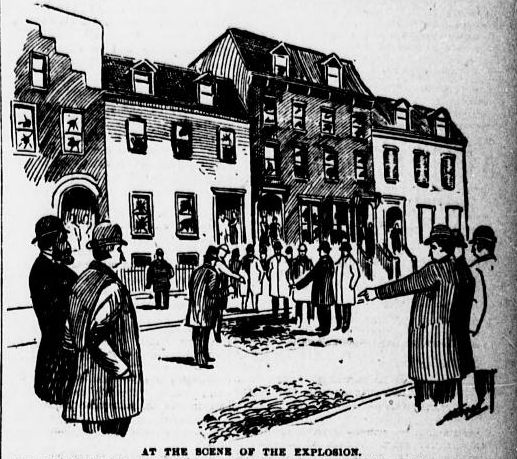
******************************************************************************************************************************** Brownstone Detectives investigates the history of our clients’ homes. The story you are about to read was composed from research conducted in the course of one of those investigations. Do you know the history of YOUR house? ******************************************************************************************************************************** It was just past 1 a.m. on a cool Saturday morning in the tony Columbia Heights section of Brooklyn. The police reserves of the Second Precinct, under the able leadership of Sergeant Joseph Carrougher, would soon be arriving on the scene. Carrougher’s desk sergeant had just awoken him out of a deep sleep at the Fulton Street police station. The sergeant had looked at him gravely in the dark of the room. “Somebody exploded a dynamite bomb on Willow Street.” “GROTESQUELY DRESSED, THE RESULT OF A HURRIED TOILET” When Carrougher arrived on the scene, he found Officer Seymour, “a portion of whose post was the scene of the explosion,” along with “a crowd of citizens” busily disturbing the crime scene. It was not too troublesome, however, having this crowd of citizens, “grotesquely dressed, the result of a hurried toilet,” tromping about the evidence. So long as they did not take anything that would assist in apprehending the guilty party. But many at the scene that night had begun amusing themselves “by digging out the fine white powder of the cobblestone with their penknives,” taking away samples. Sgt. Carrougher had seen it all in his 25 loyal years of dedication to the force. And while there were a number of clues that […]
SPRING BRINGS THE BEAN SHOOTERS (1863)
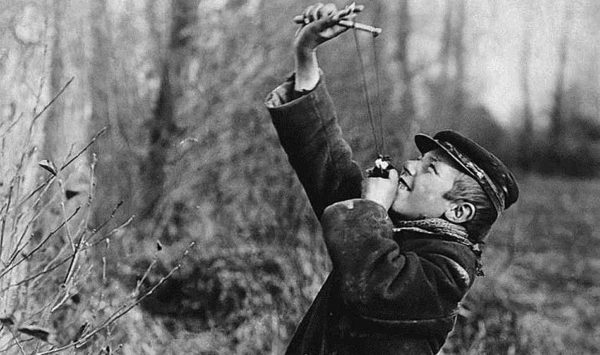
******************************************************************************************************************************** Brownstone Detectives investigates the history of our clients’ homes. The story you are about to read was composed from research conducted in the course of one of those investigations. Do you know the history of YOUR house? ******************************************************************************************************************************** There were a LOT of bad little boys in Brooklyn in the 19th century. Sifting through old issues of the Brooklyn Daily Eagle, the Standard Union, and other Brooklyn papers, I come across evidence of this on a daily basis. Of all the crimes that I see having been committed, one of the most common – and interesting – is the work of the “bean shooters.” When I was a kid I had a bean-shooter myself – and I did the same thing. There were a lot of broken window panes in my neighborhood – some I was found guilty of breaking – and most others of which I got away scot free of any blame whatsoever. (There was always the suspicion, though, that I was the culprit.) But I digress. Let’s rewind, though – further back to the mid- to late-1800s, and take a look at the work of my fierce little boy predecessors. BEAN-SHOOTING IN 19TH CENTURY BROOKLYN While sling shots (or often called “slung shots”) were a constant presence in the hands of gang members and criminals (they were outlawed by the New York State Legislature in 1849), it seems that the use of such a device by boys, with any degree of consistency, did not come until […]
THE CAT MAN OF GWINNET STREET (1896)
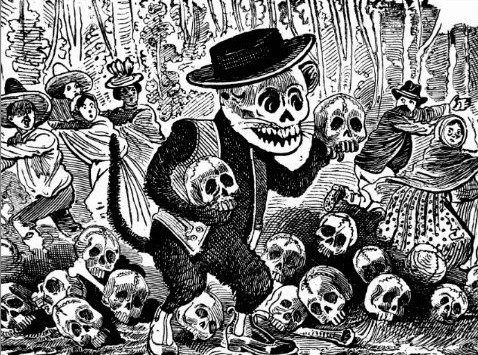
******************************************************************************************************************************** Brownstone Detectives investigates the history of our clients’ homes. The story you are about to read was composed from research conducted in the course of one of those investigations. Do you know the history of YOUR house? ******************************************************************************************************************************** Haasen-pfeffer is a German dish best served hot. A traditional German rabbit stew, it was brought over to the US by immigrants. (Hase is German for “hare,” and pfeffer is German for “black pepper.”) Although rabbits are the chief ingredient in the old-world dish, German immigrants in the early days of the country would often substitute squirrels. But never cats. Until Herman Fritsch appeared on the scene in Williamsburg in 1896. THE CAT MAN OF GWINNET STREET The locals were first alerted to the possible rabbit substitute in their stews when several neighbors heard a terrible racket occurring one night at Fritsch’s home, 168 Gwinnett Street (now Lorimer Street). As the neighbors listened, they began to hear a horrible howling coming from his rooms above a liquor store. They thought the cries sounded like “the screams of a child or woman in distress.” A consultation amongst several of the neighbors quickly took place, after which they decided that “murder was surely being committed in Fritsch’s apartments.” So Officer Lang of the Clymer Street Station was called for. While the neighbors waited, though, there was a last despairing shriek. And then all was still. OFFICER LANG ON THE JOB By the time Officer Lang arrived, “not a sound was heard” within the […]
GUERRILLA MARKETING IN A DRESS (1903)
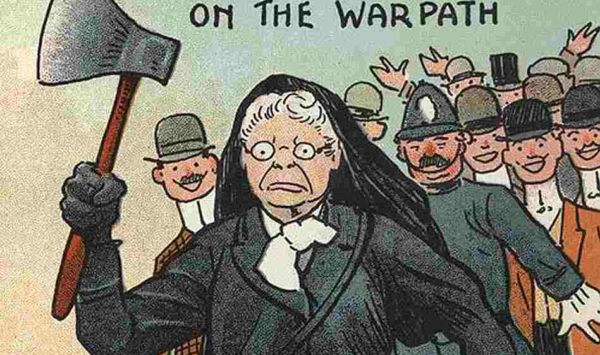
******************************************************************************************************************************** Brownstone Detectives investigates the history of our clients’ homes. The story you are about to read was composed from research conducted in the course of one of those investigations. Do you know the history of YOUR house? ******************************************************************************************************************************** When Brooklyn saloon owners saw Carrie Nation entering their Broadway establishments carrying her ax, their first thought was to protect their liquor. But when that grand and radical old figure of the Victorian temperance movement approached their bars, they were stunned at her request. “Gimme a drink – or else!” The original goal of Nation’s ax-swinging was to promote the temperance movement through the visual image of the destruction of its foe – liquor. It brought new prominence to a movement whose most visual image to date had been old women lambasting the drinking ways of men. When she started swinging that ax, though, she got attention, and so, in extension, did the temperance movement. CARRIE NATION – COMES TO BROOKLYN? But Nation, whose anti-saloon message was promoted primarily in Kansas, was a shocking sight in the Eastern District of Broadway. She had recently visited New York City, though, and so no one was willing to challenge that ax in the bars up and down the avenue – even so close to the liquor center of Brooklyn – Bushwick Avenue. “Dressed in a plush sacque, a neat fitting skirt, an old fashioned bonnet and carrying in one hand a dilapidated carpet bag and in the other a wooden ax, a person, […]
THE DAY RIOTERS STORMED BROOKLYN (1895)
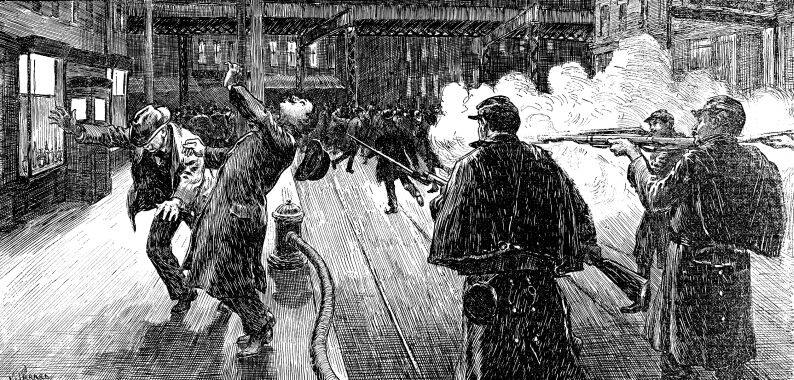
******************************************************************************************************************************** Brownstone Detectives investigates the history of our clients’ homes. The story you are about to read was composed from research conducted in the course of one of those investigations. Do you know the history of YOUR house? ******************************************************************************************************************************** (The above picture shows the New York State militia shooting a man on Halsey Street, near the corner of Broadway. You can see the recently erected elevated train line at the end of the block.) In 1895, Halsey Street near Saratoga Park had become a war zone. The Brooklyn Streetcar strike had begun on 15 January, and before the week was over the agitation would be in full force. The strike, which began with a walkout, would quickly devolve into a pitched battle between the Knights of Labor and streetcar workers on one side and the streetcar line owners, the police and the New York State Militia on the other. The main focus of much of the strikers’ attention in this part of Brooklyn, though, was the Halsey Street Rail Road Barns. These, located near the corner of Halsey Street and Broadway, were where the streetcar line stored its cars, quartered its horses, and from whence the line’s streetcars were dispatched. After the workers had called the strike, 5,500 of them would walk off the job for better conditions. The streetcar line owners (the lines were privately owned and operated at the time) countered this strike by calling in scabs who would attempt to operate the streetcars in the workers’ absence. […]
THE STOOL PIGEON & THE HOLDUP (1931)
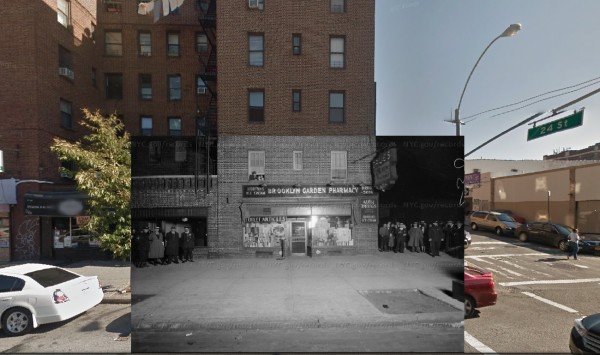
(The New York Police Department has several thousand photographs of crime scenes available online at the City’s Department of Records. Many of them are gruesome. But they are great pictures for doing research. The picture in this blog post was taken after a holdup at 729 4th Avenue in 1931. Although the pictures usually have limited or poor information associated with the photos, after a bit of some rudimentary research, we can usually find the whole story in old newspaper archives. Finding these, we are able to piece together the story behind the photograph.) THE STOOL PIGEON & THE BODYGUARD The picture above (the black & white inset photograph) is the scene of a holdup, which took place at 729 4th Avenue, Brooklyn, on 16 May 1931. Two men were shot during the event, but before it took place, another – providential – event occurred, which stymied the holdup and caused the arrests of the three men. Chile Acuna, whose revelations pried off the lid of police vice squad conditions (read about it here) was arriving home at 740 4th Avenue around 11:30 p.m. on 16 May 1931. His wife and their two kids were with them. So was their bodyguard, Patrolman William F. O’Brien. THE HOLDUP Noticing the vehicle at the curb of the drugstore across the street, O’Brien observed what happened next. He saw three men exit the vehicle while the fourth remained at the wheel. As the three men approached the drugstore, O’Brien told Acuna: “Run upstairs […]
SHE MASQUERADED IN MALE ATTIRE (1894)
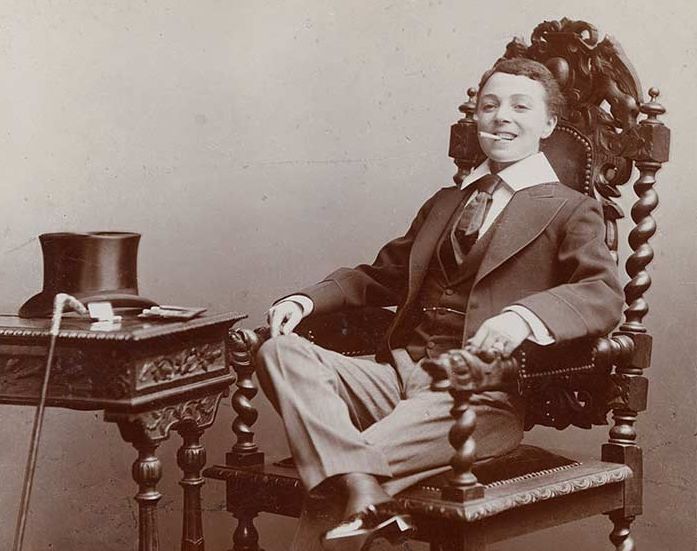
******************************************************************************************************************************** Brownstone Detectives investigates the history of our clients’ homes. The story you are about to read was composed from research conducted in the course of one of those investigations. Do you know the history of YOUR house? ******************************************************************************************************************************** Poor Mrs. Emily Lund. She was not prone to wearing men’s clothing – at least not in public. But the night in 1894 that she did dress so, she was arrested and tossed in the slammer. Officer Michael Quinn of the Hamilton Avenue police station arrested Lund, on Van Brunt, in Red Hook (or “South Brooklyn”) near William. The 55-year-old domestic had been discovered there attired “in a pair of trousers, a vest and a long mackintosh.” THE NIGHT IN JAIL After spending the night in jail, she was arraigned in the Butler street police court the next day. Her husband, who could not bring himself to even show his face, had his mother appear in his place. She brought “an outfit of women’s clothing” for his wife. When “Emily could make no coherent reply to Justice Tighe’s questions as to why she masqueraded in male attire,” Mrs. Lund’s mother-in-law told the court that her daughter-in-law’s “mind was affected.” POSTSCRIPT: “WHAT HAPPENED TO EMILY?” OR “THE POWER OF PUBLIC SHAMING” Whether that was the truth or Emily’s mother-in-law simply found the explanation convenient and a good cover up of the actual truth, it is not known. What we can guess, though, is that the Lund family was probably the butt of […]
THREE MEN AND A PIG (1892)
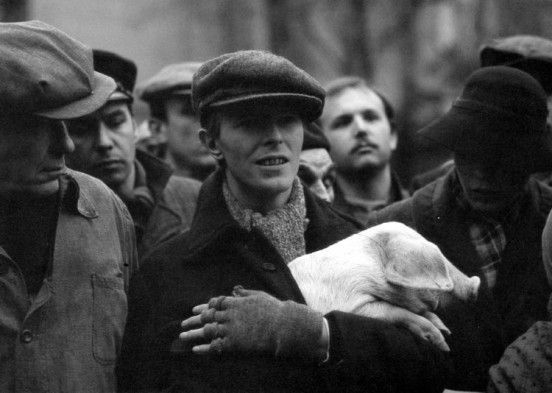
******************************************************************************************************************************** Brownstone Detectives investigates the history of our clients’ homes. The story you are about to read was composed from research conducted in the course of one of those investigations. Do you know the history of YOUR house? ******************************************************************************************************************************** (The setting of our story: The Eastern District of Brooklyn back in 1892 was a far more rural place that it is today. Comprised primarily of Williamsburg, Bushwick, and, parts of Stuyvesant Heights, the “E.D.,” as it was then called, was a semi-residential district filled with many small farmers living in frame houses and shanties, all of whom seemed to be living on the very edge of the world.) “Three men and a live, squeaking pig passed through Union avenue this morning.” The pig in the story “was an involuntary member of the quartet.” He was in the process of being stolen. “…(H)is shrill protests were heard by Policeman Farrington of the Nineteenth precinct, who traced the cries to the source. A man whom the policeman recognized as Thomas Farmer, Jr., of Union avenue and Frost street, was carrying a bag over his shoulder. “Farrington,” the story noted “gave chase and caught Farmer, who dropped the imprisoned pig on the sidewalk and showed flight. So desperate was his resistance that the officer was compelled to draw his club and a fierce fight of a few minutes’ duration terminated in the complete subjugation of Farmer.” Apparently, the two companions of the aptly named Farmer had fled. But they would not be gone […]
A STREETCAR JUMPS ON SACKETT STREET (1929)
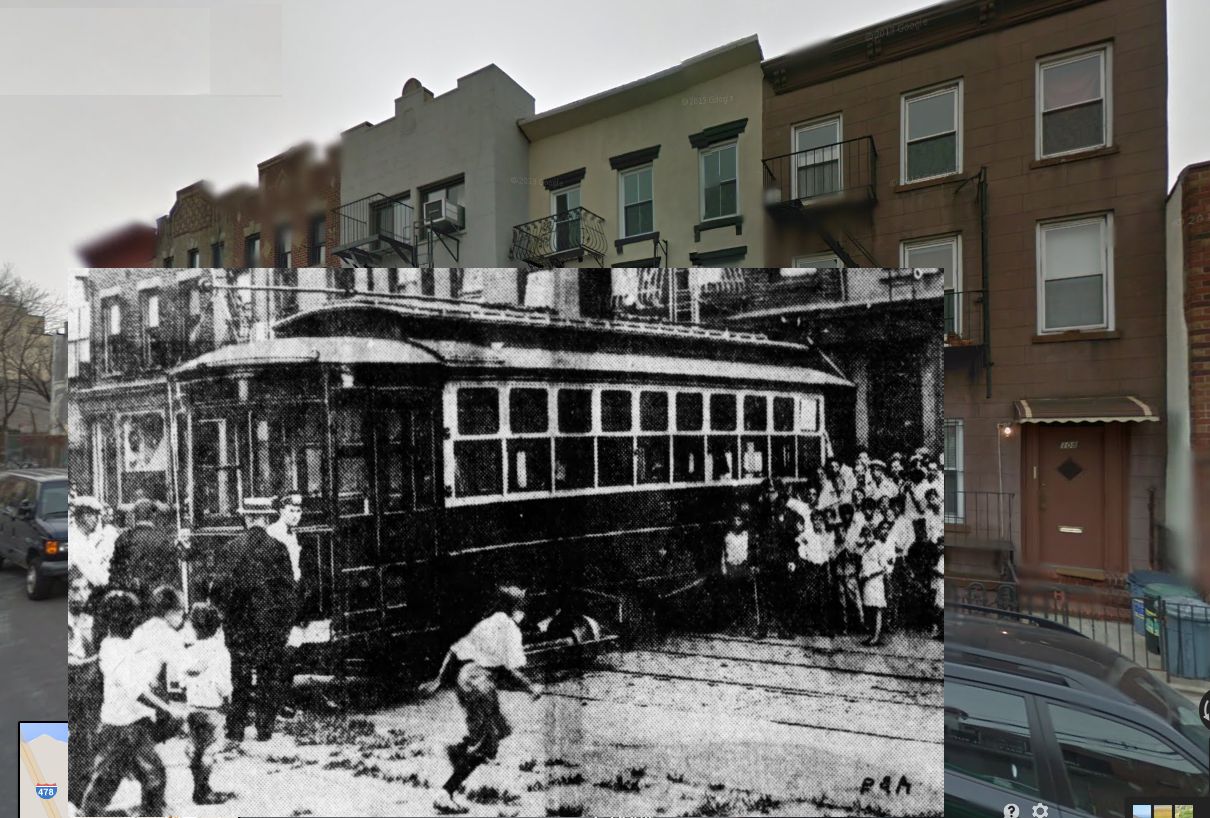
******************************************************************************************************************************** Brownstone Detectives investigates the history of our clients’ homes. The story you are about to read was composed from research conducted in the course of one of those investigations. Do you know the history of YOUR house? ******************************************************************************************************************************** If you bought a house that a streetcar had once crashed into – would you know about it? When researching the history of a client’s house, these are the stories that literally MAKE a House History Book. They are the stories that make the biggest splash – but in this case, a CRASH… But to the story… Back in the day, streetcars used to crash into buildings from time to time. The motormen’s reasons for this were usually that the car jumped the track while it was making a turn onto another street or avenue. In this instance, though, the motorman could only say that the streetcar “jumped,” but it does not appear that he was able to explain why – because he was operating the car in a straight line uphill on Sackett Street. While doing some research on a client’s home recently I saw this picture and I thought, “I didn’t even know that Sackett had a streetcar line!” Apparently, though, the line ran up and down the street back when it went both ways. The street must have been amazingly congested with these things going both ways! One day, in the Fall of 1929, though, that streetcar – starting on its run up the “slope” – literally “jumped” […]
The Reincarnation of Teddy Roosevelt (1912)

******************************************************************************************************************************** Brownstone Detectives investigates the history of our clients’ homes. The story you are about to read was composed from research conducted in the course of one of those investigations. Do you know the history of YOUR house? ******************************************************************************************************************************** 1 April 1912 – Brooklyn, N.Y. – A well-dressed man appeared in Brooklyn Police Headquarters two hours before sunrise on the 1st of April and, after introducing himself as the reincarnation of Theodore Roosevelt, “promptly dismissed all the lieutenants, detectives and policemen in the structure from the Police Department. “What appeared to be a merry jest on the part of the stranger was enjoyed until he attempted by rather progressive and aggressive tactics to yank some of the lieutenants out of the chairs and hurl them into the street in order to show his word must be obeyed,” The Evening Telegram of 1 April 1912 observed. “It then dawned on the smiling lieutenants, detectives and policemen that the reincarnation of the Rough Rider was not in any sense an April Fool joker.” “Teddy” – or Joseph Condon, of No. 142 Atlantic Avenue – was evidently very much under the impression, though, that he was – if not Theodore Roosevelt, himself – the reincarnation of same. “Roosevelt” thereupon imposed a three months’ fine on Policeman Franklin and then assigned him to Tottenville, Staten Island. When Franklin asked “Teddy” to show him the way there, Condon said he would not go until the dismissed lieutenants, detectives and policemen had left the building. After […]